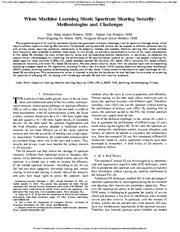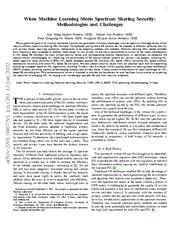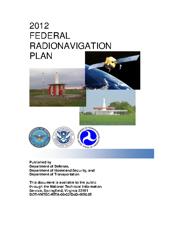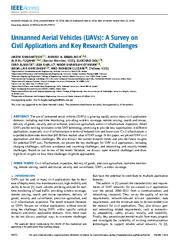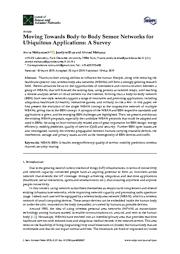A copy of this work was available on the public web and has been preserved in the Wayback Machine. The capture dates from 2016; you can also visit the original URL.
The file type is application/pdf.
Filters
Unmanned aerial vehicle relative navigation in GPS denied environments
2016
2016 IEEE/ION Position, Location and Navigation Symposium (PLANS)
This paper considers the problem of target handoff between Unmanned Aerial Vehicles (UAVs) in a GPS denied environment, and focuses on the design and evaluation of an estimation strategy for determining ...
The estimation approach presented in this paper has three distinct components that act in concert to achieve the overall objective. ...
For this work, our specific motivation is to enable target handoff between two UAVs flying in a GPS-denied environment. ...
doi:10.1109/plans.2016.7479719
dblp:conf/plans/HardySG0KDT16
fatcat:jy2wf4czeffuhok7c5gsypnpju
Mobile telemedicine sensor networks with low-energy data query and network lifetime considerations
2006
IEEE Transactions on Mobile Computing
In this paper, we use an integrated architecture that takes advantage of the low cost mobile sensor networks and 3G cellular networks to accommodate multimedia medical calls with differentiated Quality-of-Service ...
Our results clearly indicate the energy efficiency of the proposed sensor network query algorithms and the efficiency of our multiclass medical call admission control scheme in terms of meeting the multimedia ...
For handoff calls of the other three classes, we used an adaptive guard channel scheme to achieve the target HDP of each call. ...
doi:10.1109/tmc.2006.1599408
fatcat:wujte3x6gvdjnjxcnbn6iu2tji
A Comparative Survey of VANET Clustering Techniques
2017
IEEE Communications Surveys and Tutorials
obstacles which limit physical connectivity in urban environments. ...
This paper explores the design choices made in the development of clustering algorithms targeted at VANETs. ...
This method is unique in that it does not need GPS data, which can be inaccurate in built-up areas, but instead estimates proximity from a connectivity standpoint. ...
doi:10.1109/comst.2016.2611524
fatcat:fzsfwzbdnvhajgpovv67mif3f4
Survey on Near-Space Information Networks: Channel Modeling, Networking, and Transmission Perspectives
[article]
2024
arXiv
pre-print
A comprehensive review of the networking techniques of NSINs in network deployment, handoff management, and network management aspects is provided. ...
Finally, we outline some open issues and promising directions for NSINs deserved for future study and discuss the corresponding challenges. ...
Different from a HAP, a UAV has a relatively small footprint. Yet, like a HAP, the size of the UAV footprint is closely related to the deployment environment. ...
arXiv:2310.09025v4
fatcat:2hyaknuhhfb43aza66xp2o5xee
Air-to-air missile vector scoring
2011
2011 IEEE International Conference on Control Applications (CCA)
Frequency modulated continuous wave radar sensors, carefully located to provide spherical coverage around the target, provide updates of missile kinematic information relative to a drone aircraft. ...
An air-to-air missile vector scoring system is proposed for test and evaluation applications. ...
One potential drawback in this estimation scheme is the potential for GPS satellite outages or jamming degrading or denying scores.
Radar Sensors. ...
doi:10.1109/cca.2011.6044487
dblp:conf/IEEEcca/SweeneyF11
fatcat:2j3cljigmzc2voeiijlqj2gct4
When Machine Learning Meets Spectrum Sharing Security: Methodologies and Challenges
2022
IEEE Open Journal of the Communications Society
In particular, we elaborate the state-of-the-art methodologies for improving the performance of SS communication systems for various vital aspects, including ML based cognitive radio networks (CRNs), ML ...
In this article, we provide a comprehensive survey of the recent development of ML based SS methods, the most critical security issues, and corresponding defense mechanisms. ...
head. ...
doi:10.1109/ojcoms.2022.3146364
fatcat:ffx3xbq5qzb6hcserskljb4o7u
When Machine Learning Meets Spectrum Sharing Security: Methodologies and Challenges
[article]
2022
arXiv
pre-print
In particular, we elaborate the state-of-the-art methodologies for improving the performance of SS communication systems for various vital aspects, including ML based cognitive radio networks (CRNs), ML ...
In this article, we provide a comprehensive survey of the recent development of ML based SS methods, the most critical security issues, and corresponding defense mechanisms. ...
head. ...
arXiv:2201.04677v1
fatcat:gb73bku37fatncamax67buwkea
Trace: Tennessee Research and Creative Exchange An Analysis of Target Location Error Generated by the Litening Pod as Integrated on the AV-8B Harrier II Acceptance for the Council: an of AN ANALYSIS OF TARGET LOCATION ERROR GENERATED BY THE LITENING POD AS INTEGRATED ON THE A V-8B HARRIER II
2005
unpublished
The number one recommendation for minimizing the TLE for Tpod generated target coordinates is to fix the aircraft software to properly set the relative bit for Tpod targeting. 111 PREFACE The technical ...
The Litening Pod {Tpod), as integrated on the A V-8B Harrier, can now be easily used by the pilot as a target coordinate generation source for global positioning system (GPS) guided weapons. ...
Minimizing aircraft handoff error is especially important when JDAM is released to guide to earth-based (absolute) coordinates using JDAM INS-only navigation such as in a GPS denied environment. ...
fatcat:62tkmpsydbajdajnerixsmyptm
The Federal Radionavigation Plan
1981
Navigation
exercise civil contingency responses to ensure continuity of operations in the event that access to GPS is disrupted or denied. ...
A pilot can request information for the estimated time of arrival or ask for the GPS availability over a window of up to 48 hr. ...
Appendix D
Acronyms The following is a listing of abbreviations for organization names and technical terms used in this plan: Appendix E Glossary Accuracy -The degree of conformance between the estimated ...
doi:10.1002/j.2161-4296.1981.tb00771.x
fatcat:uiqoj4rvxbb5znxcn3vu55lfsm
Unmanned Aerial Vehicles (UAVs): A Survey on Civil Applications and Key Research Challenges
2019
IEEE Access
In this survey, we present UAV civil applications and their challenges. We also discuss current research trends and provide future insights for potential UAV uses. ...
Smart UAVs are the next big revolution in UAV technology promising to provide new opportunities in different applications, especially in civil infrastructure in terms of reduced risks and lower cost. ...
It is very difficult to use GPS for avoiding collisions in an indoor environment, usually indoor is a GPS denied environment. ...
doi:10.1109/access.2019.2909530
fatcat:xgknpyuqazhpvferjkkdohxmtu
A critical evaluation of location based services and their potential
2007
Journal of Location Based Services
Geopositioning Location or position determination, or 'geopositioning', is a crucial technology for LBS, as is the contextual mapping of the natural and built environment. ...
In one mode this could be a question asked by a service provider, an employer, an emergency management worker, who wants to track or find an object or person for a range of reasons. ...
Acknowledgements The Editorial team of JLBS wish to thank the publishing team at Taylor and Francis for their support in establishing the Journal, the members of the Editorial Board who have reviewed this ...
doi:10.1080/17489720701584069
fatcat:spmkpyyds5bzfnmu7dgidrcpqq
Paradigms for Algorithms and Interactions
[chapter]
2010
Cooperating Embedded Systems and Wireless Sensor Networks
Embedded WiSeNts Paradigms for algorithms and interactions ...
The aim of the study is to identify the areas that need further research and the most promising design approaches in the context of CObased systems. ...
Two interesting ideas appeared in [134] and later in [135] . While these works address target tracking in sensor networks, the estimation of target position is closely related to localization. ...
doi:10.1002/9780470610817.ch3
fatcat:y6rg4ciutvelxkwt72fhwzdyd4
Defense Advanced Research Projects Agency (Darpa) Fiscal Year 2015 Budget Estimates
2014
Zenodo
Included in this category is the National Center for Advancing Translational Sciences (NCATS) efforts to reengineer drug discovery and development in collaboration with industry, academia, the Food and ...
Also cited under this heading is the proposed DARPA-like funding mechanism to stimulate technology development, which is detailed below. ...
This program will transition to the Services, emphasizing platforms that operate in GPS-denied environments. ...
doi:10.5281/zenodo.1215345
fatcat:fjzhmynqjbaafk67q2ckcblj2m
Can You See Me Now?: Toward Reasonable Standards for Law Enforcement Access to Location Data that Congress Could Enact
2012
Social Science Research Network
even judges in the same district may require law enforcement to meet different standards to compel location data. ...
This Article proposes a legislative model for law enforcement access standards and downstream privacy protections for location information. ...
it is not already-outdated with the deployment of microcell, picocell, and femtocell technology that, in some cases, can be more accurate than GPS. 69 Indeed, in urban areas and other environments where ...
doi:10.2139/ssrn.1845644
fatcat:acde37w5svgjpksggzqncatnry
Moving Towards Body-to-Body Sensor Networks for Ubiquitous Applications: A Survey
2019
Journal of Sensor and Actuator Networks
for BBN design: energy efficiency, mobility prediction, quality of service (QoS) and security. ...
In this paper, we first present the evolution of the single WBAN concept to the cooperative network of multiple WBANs, giving rise to the BBN concept. ...
For example, the public hospital environment could be targeted by malicious behaviors from the inside or the outside. ...
doi:10.3390/jsan8020027
fatcat:u4fjgqfqajeupex74jgftxjvxa
« Previous
Showing results 1 — 15 out of 69 results






